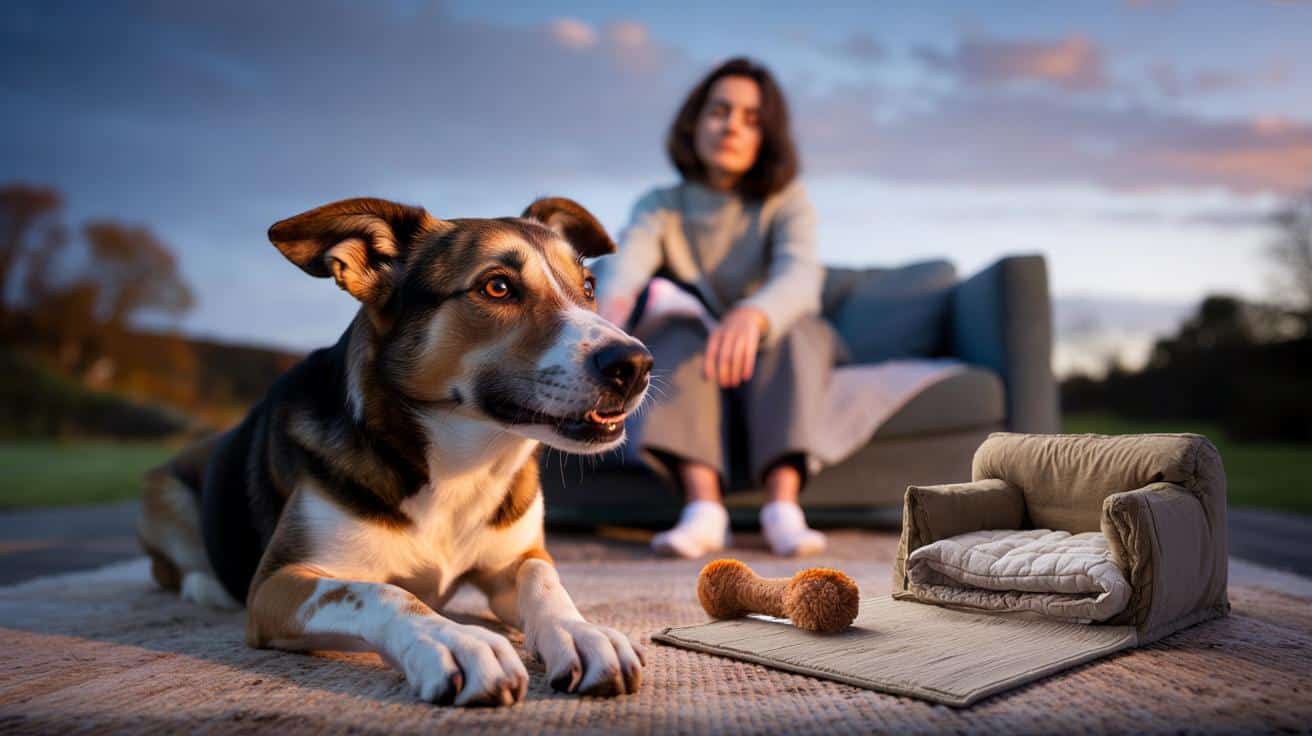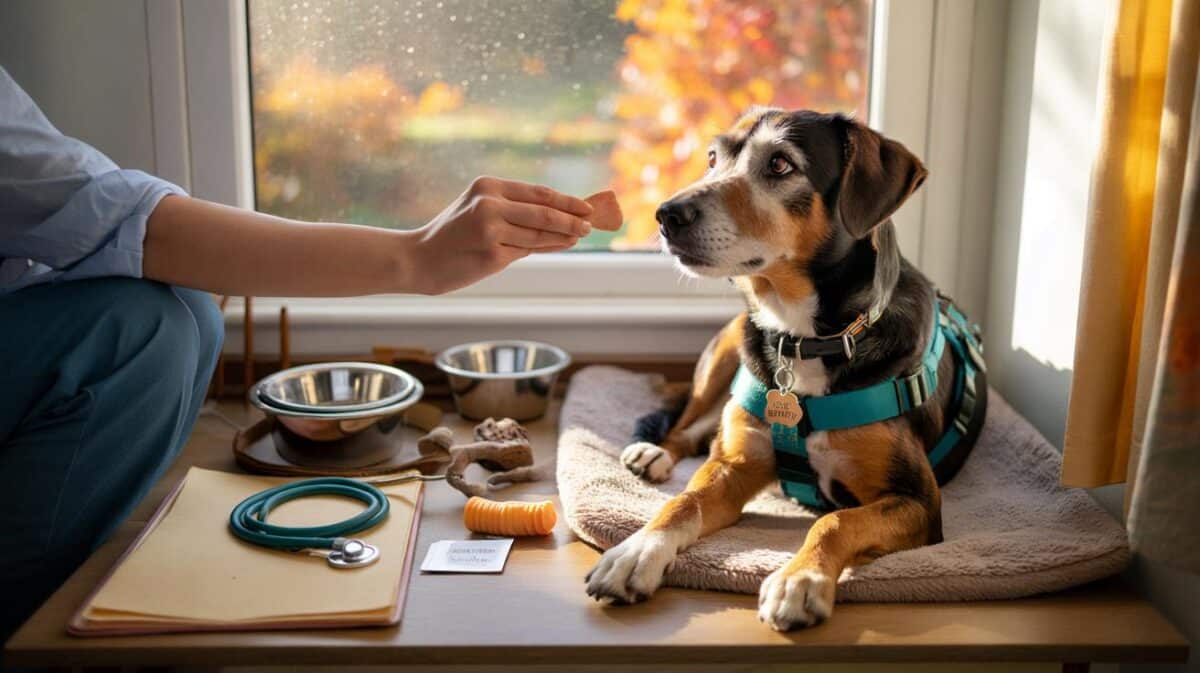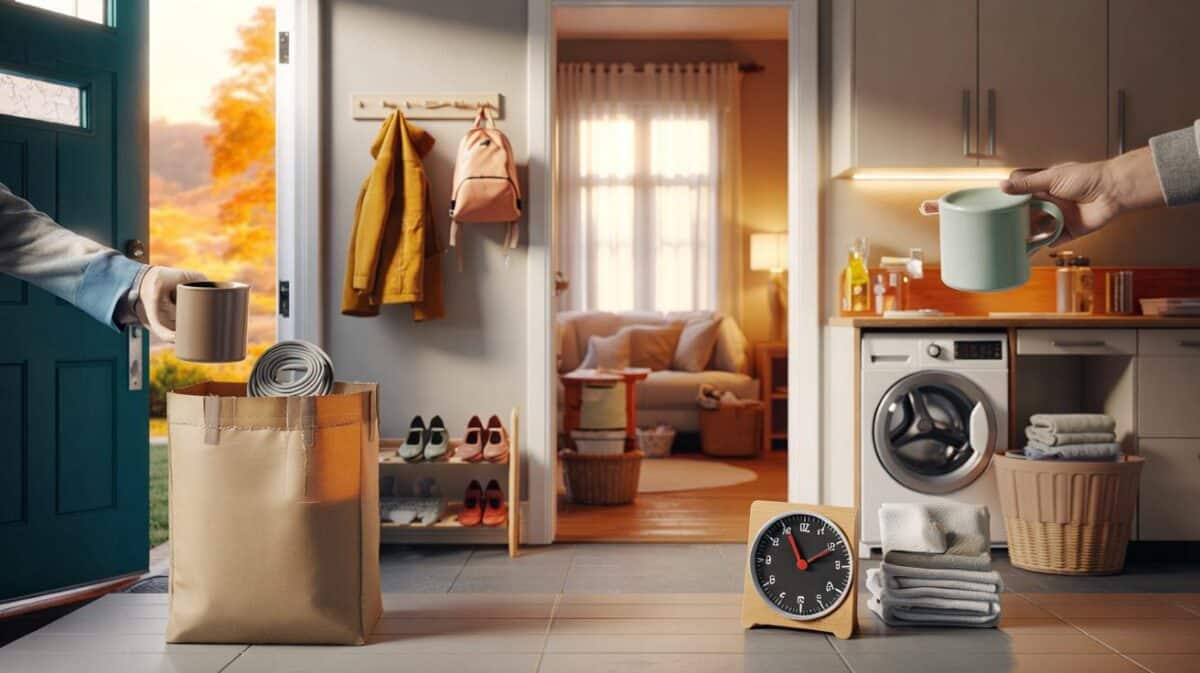If you feel stretched, your dog likely notices before anyone else. They read your tone, your gait and your breath. They adapt fast. Some dogs carry that tension as if it were theirs, especially when days shorten and routines shift.
The autumn squeeze: why your dog mirrors your mood
Dogs live by patterns. October and early November bring colder walks, shorter daylight and busier evenings. Those changes unsettle people. Dogs pick up the ripples through our voice, posture and pace. Many become clingy, others retreat under a table, some go off their food. Sensitive breeds and dogs with a rough past can react more sharply.
Dogs read our tone, posture and pace long before we say a word. Calm is a cue; tension is a cue.
The stress loop in three moves
- You tense after a long commute; your speech quickens and shoulders lift.
- Your dog scans you, then switches state: hypervigilant, glued to you, or hiding.
- You respond to the new behaviour, often with more tension. The loop tightens.
Break the loop early and the house steadies. Wait, and you may see stomach upsets, restless nights or snapping over minor handling. Autumn’s grey mood can amplify those patterns because walks shorten, damp weather prunes play, and boredom grows teeth.
Spot the red flags early
Seven signs to watch this week
- Yawning outside sleep times, often stacked with lip licking and head turns.
- Ears pinned or angled back when you move quickly or raise your voice.
- Panting indoors at rest, especially if the room is cool and quiet.
- Shadowing you from room to room or, the reverse, avoiding contact.
- Changes in appetite over two or more consecutive meals.
- Vocalising when left for short periods, or destructive chewing near exits.
- Gastro upsets within 24–48 hours of routine disruption or noisy evenings.
| Sign | What it may signal | First step at home |
|---|---|---|
| Indoor panting at rest | Heightened arousal or pain | Offer a quiet den, reduce excitement; call the vet if it persists |
| Clinginess or hiding | Seeking safety | Provide choice: safe spot, gentle presence, no forced contact |
| Loss of appetite | Stress or GI discomfort | Smaller, bland meals; monitor hydration; vet if over 24 hours |
| Destruction by doors | Separation distress | Short absences with chew options; avoid big goodbyes |
| Excessive grooming | Self-soothing habit | Redirect to long-lasting chews; schedule calm activity |
Fast fixes you can use tonight
The 20-minute reset routine
Give yourself and your dog a brief, predictable reset after work. No phone, no TV, just a gentle sequence that tells both of you, “we’re safe now.”
- Minutes 0–3: breathe slowly through your nose, drop your shoulders, speak softly. Your dog reads your exhale.
- Minutes 3–10: take a slow, scent-led walk. Let the lead stay loose; pause for sniffing every 20 metres.
- Minutes 10–15: offer a calm activity at home: a stuffed chew, a simple forage mat, or a slow grooming session.
- Minutes 15–20: quiet companionship. Lights lower, movement minimal, a few strokes if the dog solicits touch.
Predictable beats perfect. Your dog prefers the same small routine daily over dramatic one-off efforts.
Back to basics that actually change the day
- Hold feeding times within a 30-minute window morning and evening.
- Keep two walks daily, even in drizzle; shorter is fine, but sniff time matters.
- Add one job for the brain: scatter-feed, a cardboard “treasure” box, or a 10-minute scent game.
- Build a den: a bed in a low-traffic corner, with a blanket and a chew reserved for that space.
- Use your voice as a tool: low, slow phrasing lowers arousal faster than repeated commands.
- Massage lightly around ears and shoulders for 2–3 minutes, then pause; let the dog ask for more.
When home strategies aren’t enough
Some patterns need professional eyes. If anxiety persists for more than two weeks, or escalates quickly, call your vet. Pain, gastric irritation, skin flare-ups and early arthritis can sit underneath “behaviour”. A veterinary exam rules out medical drivers before you adjust training. A qualified behaviourist can then map triggers and design gradual change.
Look for change, not perfection: fewer incidents each week and faster recovery tell you you’re on the right track.
Seek urgent help if your dog shows sudden aggression, refuses water, pants heavily at rest for over 30 minutes, or cannot settle at night. Keep records: dates, times, weather, noise, duration of absences and what helped. That log shortens the road to a plan that works.
Timely notes for UK owners this season
Bonfire night, fireworks and the “stress carry-over”
Early November brings fireworks that can shake even steady dogs. Stress from one noisy night often carries into the next day. Plan a buffer: a morning sniff walk, a heavier afternoon meal 90 minutes before dark, and a pre-arranged safe room with blinds drawn. Add steady background sound and a long-lasting chew.
- Keep ID tag and microchip details current in case of bolting.
- Avoid punishment for noise responses; it pairs you with the fear.
- Trial any calming wrap, pheromone diffuser or supplement days before, not on the night.
Extra pointers that widen your options
The two-to-one rule and the stress budget
For every challenging event a dog faces in a day—builders next door, a crowded bus, a rushed morning—stack two calming experiences. That ratio keeps the “stress budget” solvent. Examples include a woodland sniff, a chew after dinner, or five minutes of nose-target games. Small, frequent deposits stabilise behaviour better than one big weekend blowout.
Match activity to the dog you have
High-drive adolescents thrive on short, brainy intervals: three 5-minute training bursts and two 20-minute walks beat one frantic hour. Seniors benefit from joint-friendly sniff trails and padded resting spots. Flat-faced breeds overheat indoors more easily; prioritise cool rooms and gentle play. Rescue dogs may need weeks of sameness before they can add novelty.
If you consider supplements, check them with your vet first, especially if your dog takes prescribed medication. Never give human anxiety drugs. Pheromone diffusers, gentle pressure garments and tailored behaviour plans often pair well, but they work best when the household’s pace also slows. Your dog watches what you do, not what you promise.








